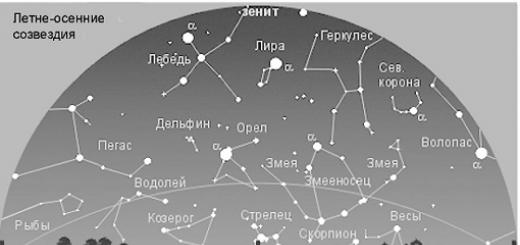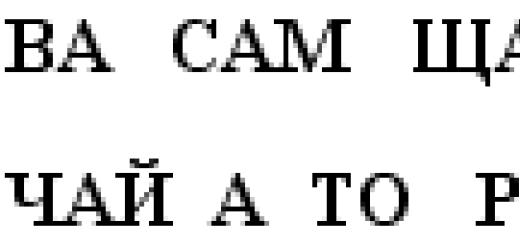The basic unit of length is the meter (m). Initially, the distance between two strokes on a specially made platinum-iridium rod 102 cm long, stored at the International Bureau of Weights and Measures in Paris, was taken as a sample (standard) of a meter (Fig. 14). The material and cross-sectional shape of the rod and its storage conditions were chosen in such a way as to best ensure the stability of the sample. In particular, measures were taken to maintain a constant temperature of the rod. Carefully made secondary standards - copies of this sample - are stored in the institutes of measures and weights of different countries.
Rice. 14. Initial standard of the meter (general view and section)
It was supposed to make a sample of a meter equal to one forty-millionth of the length of the earth's meridian. When the insufficient accuracy of measurements on the earth's surface became clear, they did not replace the manufactured sample or make corrections based on more accurate measurements, but decided to keep the sample itself as a unit of length. This pattern is about 0.2 mm smaller than 1/40,000,000 of a meridian.
In addition to this basic unit, other units are also used in science and technology - decimal multiples and submultiples of a meter:
kilometer (1 km=1000 m);
centimeter (1 cm=0.01 m);
millimeter (1 mm=0.001 m);
micrometer (1 µm=0.001 mm=0.000001 m);
nanometer (1 nm=0.000000001 m).
In England, the USA and some other countries, the so-called English measures of length are widespread:
inch = 25.4mm;
ft = 12 inches = 304.8 mm;
land mile ("statute") = 1609 m;
nautical mile ("Admiralty") = 1852 m (the length of one minute of the arc of the earth's meridian).
The old Russian measures of length were:
vershok = 4.445 cm;
arshin \u003d 28 inches \u003d 16 inches \u003d 0.7112 m;
sazhen \u003d 3 arshins \u003d 2.1336 m;
verst = 500 fathoms = 1.0668 km;
Russian mile = 7 versts = 7.4676 km.
The abundance of different units of length (as well as units of other physical quantities) is very inconvenient in practice. Therefore, international standard definitions of units of all physical quantities were developed. The collection of these definitions is called the SI system of units (from the words Systeme Internationale - International system). Since 1963, in the USSR and a number of other countries, SI has been recommended for use in all fields of science and technology.
According to this system, a meter is defined as a length equal to 1,650,763.73 wavelengths of orange light emitted by a special lamp in which krypton-86 gas glows under the action of an electric discharge. The number of lengths of will is chosen so that this unit of length coincides as closely as possible with the Parisian metre. Therefore, the unit was not chosen as the length on which any round number (for example, one million) of wavelengths would fit. This new unit of length can be reproduced (optically) with greater accuracy than the archival sample. It is very convenient that in order to reproduce a unit of length, one does not need to refer to a single stored sample, but it is enough to make a special krypton lamp and observe the light emitted by it.
In practice, to measure length, including to measure the distances between two positions of a point on a trajectory, copies of secondary standards are used: rods, rulers or tapes with divisions equal to the length of the standard, or its part (centimeters, millimeters). When measuring, the beginning of the measuring ruler is combined with one end of the measured segment and its division is noted, against which the second end of the segment will be. If the second end does not coincide with any of the divisions of the ruler, then “by eye” it is estimated at what fraction of the distance between the divisions it turned out to be.

Rice. 15. Vernier caliper
To reduce the inevitable reading error, various auxiliary devices are used. On fig. 15 shows one of them - a vernier mounted on a caliper. The vernier is an additional scale that moves along the main scale. Noius divisions are less than divisions of the main scale by 0.1 of their size; for example, if the division of the main scale is 1 mm, then the division of the vernier is 0.9 mm. The figure shows that the diameter of the measured ball is greater than 11 mm, but less than 12 mm. To find how many tenths of a millimeter is the remaining fractional part of the division, look at which of the strokes of the vernier matches any of the strokes of the main scale. In our drawing, this is the ninth stroke of the vernier. This means that the eighth, seventh, etc. strokes of the vernier will be ahead of the previous strokes of the main scale closest to them by 0.1 mm, 0.2 mm, etc., and the initial stroke of the vernier will be 0.9 mm ahead of the nearest one to him the previous stroke of the main scale. It follows that the diameter of the ball is equal to as many whole millimeters as they fit from the beginning of the main scale to the beginning of the vernier scale (11 mm), and as many tenths of a millimeter as the divisions of the vernier fit from the beginning of the vernier scale to matching strokes (0.9 mm) . So, the measured diameter of the ball is 11.9 mm.
Thus, the vernier allows you to measure distances with an accuracy of 1/10 of the scale division.
s; and. 1. The stretch of something; distance between whom, than l. Measures of length. Measure length and width. D. straight line segment. D. way. D. shipping channel. Full length. Three meters long. 2. Duration, duration (about time). D. working day. ... ... encyclopedic Dictionary
LENGTH, lengths, pl. no, female The extension of a line, plane, body in the direction in which the two extreme points (lines, planes, bodies) lie at the greatest distance from one another. Items are measured in length, width and height. Table length. Measures… … Explanatory Dictionary of Ushakov
Female stretch along, valley; psk. valley, valley, tver., psk. length, perm. share; for the length of space, body or thing is usually taken the direction of its greatest extent; length, width and height, or a level measure along and across and a measure along ... Dahl's Explanatory Dictionary
Exist., f., use. comp. often Morphology: (no) what? length for what? length, (see) what? length than? length about what? about length; pl. what? length, (no) what? length for what? lengths, (see) what? length than? lengths, what? about lengths 1. The length of an object is ... Dictionary of Dmitriev
1) The length of a straight line segment is the distance between its ends. 2) The length of a broken line is the sum of the lengths of its links. 3) The length of an arc of a curve is the limit of the length of a broken line inscribed in it, when the number of its links increases indefinitely, and the length of each link tends to zero ... Big Encyclopedic Dictionary
Duration, length, distance, duration, longitude; perimeter, footage, picket, extension, apothem, extension Dictionary of Russian synonyms. length 1. length, length 2. see duration ... Synonym dictionary
length- LENGTH1, s, w The length of an object, the distance between its two extreme points, located on the same line or one plane and located at the greatest (in contrast to width) distance from each other. Pavel increased the length of the trousers in ... ... Explanatory dictionary of Russian nouns
English long A message about the presence of securities in the dealer, made in exchange jargon, where the number of shares is replaced by the term length. Dictionary of business terms. Akademik.ru. 2001 ... Glossary of business terms
From *length, cf. other Russian d (b) for length (e.g., in Khozh. igum. Dan. 18). From to last; cf. Ukrainian duration, st. glory. prolong μηκύνειν, Czech. dlim, dlit. Kindred Praslav. * dьlgъ (see long); cf. Bernecker 1, 252 ff.; Trautman, BSW 55; mi. EW 55.… … Etymological Dictionary of the Russian Language by Max Fasmer
LENGTH, s, pl. (special) lengths, lengths, lengths, wives. The size, length of something. in the direction in which the two extreme points of the line, plane, body lie, in contrast to the width, at the greatest distance from each other. Measure the table in length and in ... ... Explanatory dictionary of Ozhegov
Books
- Length, area, volume, G. A. Merzon, I. V. Yashchenko. The sixth book in the series `School Mathematical Circles` is devoted to various approaches to comparing and calculating areas and volumes and is intended for classes with schoolchildren in grades 6-11. In her…
- The length of the shadow from a rotten stump, Valentin Pikul. “... in ancient times, the banks of the Luga were completely lined with villages, very densely populated by peasants and the nobility, and the river itself was famous for navigation in ancient times, even ...
> Length
Explore length in physics: how the length is indicated, the letter and length formula, how to find. Read about the designation of length, unit of measure, definition, types of quantities.
Length is one of the basic characteristics of measuring an object in physics.
Learning task
- Understand the definition of the length of an object.
Key Points
- Length is the measure of the longest dimension of the body.
- Deformation is a change in length.
- The unit of measurement is meter.
Terms
- Special Relativity: reconciles the principle of relativity with the reference that the speed of light remains constant in all frames of reference.
- Dimension - a measure of spatial extent in a particular direction (height, width, depth, length).
Length
Length in physics reflects one of the characteristics of an object. Moreover, this concept is widely used in everyday sense. For example, you can cut a certain length of wire. It can differ from height (vertical length) or width (distance between sides).
Length is a measure of one dimension, area is two (the square of length), and volume is three. Due to special relativity, length is not considered constant in all frames of reference. Therefore, your meter ruler will not display one value. It changes depending on the observer.
Units
What is the unit of length in physics? One of the oldest measurements is the cubit (from the tip of the finger to the elbow). Then it was divided into a leg, arm or finger. Could also increase - a step. However, such units are not stable, because the size of the cubit varies depending on the person.
In physics, length has become synonymous with distance. Units can be based on body parts or distance traveled between certain points. The official is the meter and is determined in relation to the speed of light. Also used in centimeters and kilometers. In the English system - inch, foot, yard and mile. When it comes to cosmic distances, they use a light year and a parsec.
Metric length 1 km is equivalent to 0.62137 miles
Length should be understood as a physical quantity, which is a characteristic of the length of lines in numbers. This concept has several definitions that you should be aware of. Units, tools and devices for measuring length are also different. Therefore, in this article we will tell you how and how to measure the length.
What is length
As we have already said, the concept of length should be understood as a physical quantity. In the narrow sense of the word, it means the size in the longitudinal direction. That is, length can be called the distance between two points of an object that are as far as possible from each other. However, it is important to note that this distance should be measured horizontally, and not vertically, as in the case of height measurements.
In physics, the concept of length is equivalent to the term "distance". It should also be noted that in the vast majority of measurement systems, length is the main unit of measure, with which other units are established. In the international system of units, the unit of length is the meter.
Length units
First of all, it is necessary to say about the metric system, which to this day is the most convenient because of its simplicity. It is based on the unit of measurement meter, and the rest are multiple powers of ten from it. For example, a kilometer is 10 meters cubed. This system greatly simplifies the calculations.
In Russia, a person was a measure of length for a long time. This can be judged by the names of the measures, including span, elbow, sazhen and others. A span is a measure corresponding to the distance between the index and thumb in an extended position, an elbow is the length from a clenched fist to the bend of the elbow, and a fathom is from the end of the fingers of one hand to the end of the other.
From various works of literature, we also know such a unit of distance as a verst. It corresponds to today's 1,066.8 meters. In Ancient Russia, miles were boundary and travel. The first were used to measure land, the second - distances or paths.
In England and America, other units were used. For a long time in Britain, the following units of length existed:
- mile;
- inch.
The yard is not included in the international system of units and is equal to 0.9144 meters. The mile came from ancient Rome, where it was equal to a thousand double steps of a soldier. This unit is still used in a number of countries where the metric system of measures is not used. In different countries, its value is different. In England, it corresponds to 1.6 kilometers. The foot is also not included in the international system and corresponds to 0.3048 meters. An inch, which is used today in the United States and Britain, is equal to 2.54 centimeters.
In addition, there is also a nautical system for measuring length, which is based on the unit of measurement - the nautical mile. It is equal to the length of one minute of the earth's ellipsoid meridian arc. Its length is a variable and depends on latitude. The international nautical mile is 1852 meters.
Length measurement tools
The simplest tool for measuring length is a ruler, which is a narrow plate. On it, as a rule, there are divisions corresponding to the unit of measurement. It can be a millimeter, centimeter, inch, etc. In cartography and geometry, this tool is used only for the purpose of drawing straight lines. Other instruments are used to measure distances, and measuring length with a ruler is considered insufficiently accurate.
Another common tool for measuring the length of an object is a tape measure. It is a tape on a reel, which is wound into the body using a special mechanism. It also has divisions in the form of strokes in accordance with the unit of measurement. Most often there are roulettes 3 or 5 meters long. However, there are also instruments that allow you to measure lengths up to 100 meters.
It should also be said about the end block of length, which is often referred to as KMD. It is an exemplary measure of length (0.5-1000 millimeters), which is made in the form of a round cylinder or a rectangular parallelepiped. Gauge block is designed to store and transmit a unit of length. It is with its help that the verification and establishment of the size of measuring instruments takes place.
Distance measuring instruments
The so-called rangefinder is a device for determining the distance from the observer to a certain object. Rangefinders are active and passive. The former include laser, sound and light rangefinders, and the latter are devices that use matching an object to a specific sample or optical parallax.
Separately, we should talk about such a device as a radio range finder. It helps to determine the distance using radio waves. This device is used in military affairs, in space and air navigation and in other areas. This device sets the time it takes for a radio wave to travel from it to a specific object and back. Thus, the distance to a given object is directly proportional to the time interval.
According to the measurement method, such devices are divided into pulse radio range finders and phase ones. In the first case, the delay time of the reflected signal is measured, while in the second, the number of wavelengths that fit in the signal path is determined.
It is important to add that very small distances are usually measured using so-called measuring microscopes. And very large ones are installed by means of satellite and radio navigation systems for measuring length.










